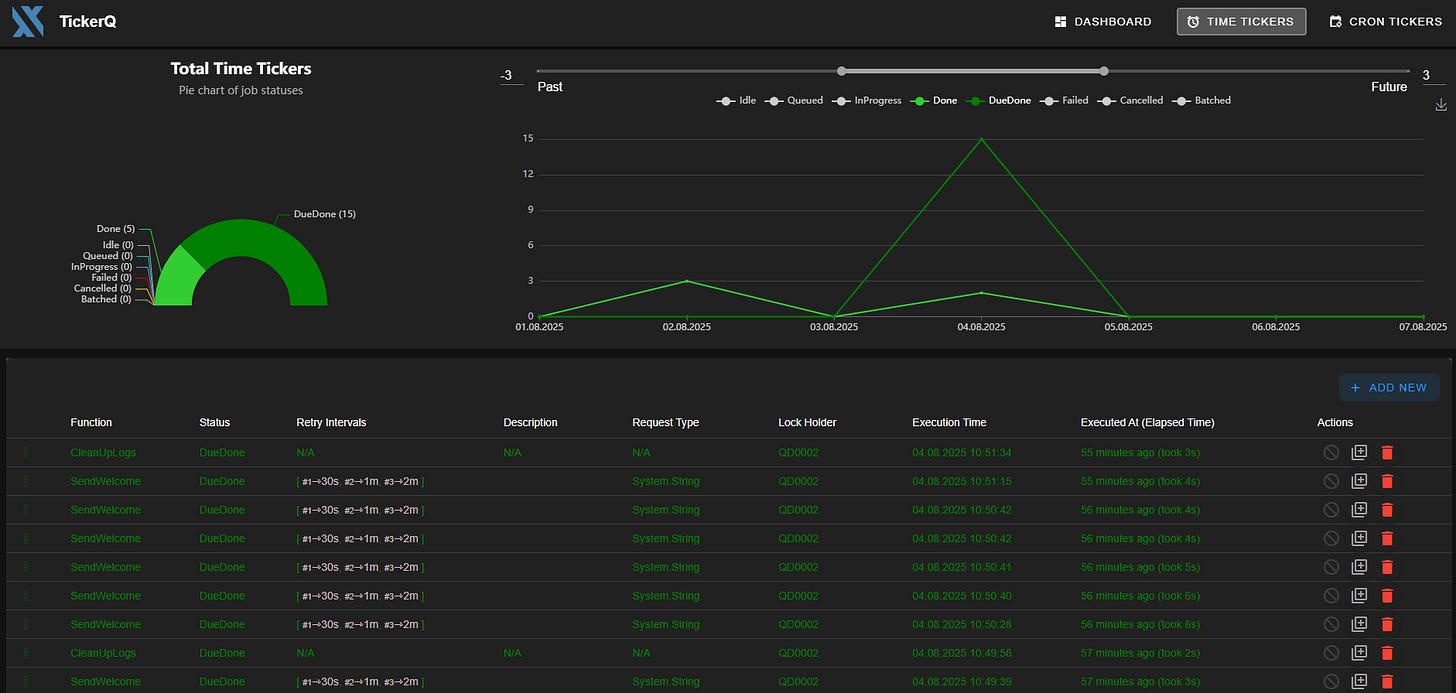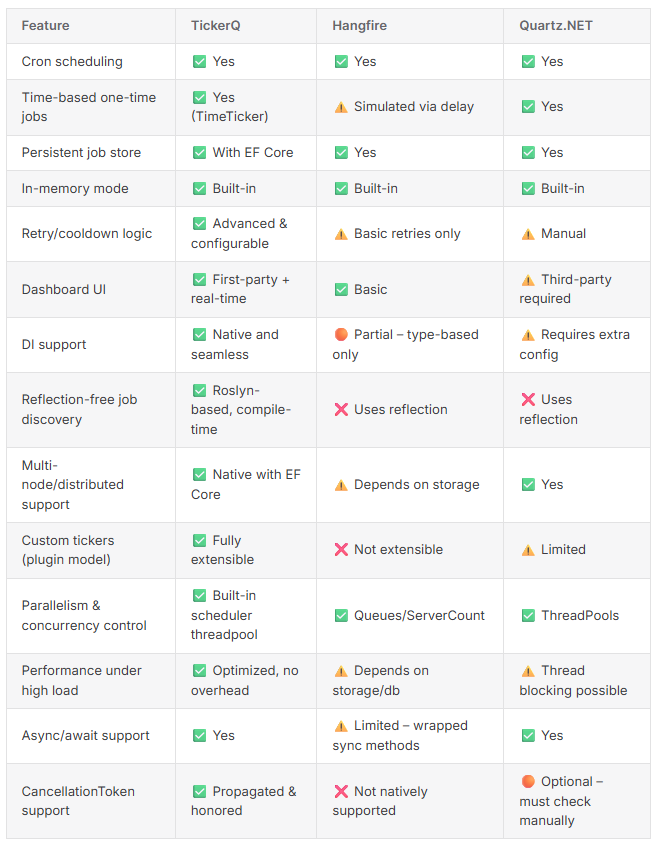🚀 Meet TickerQ – A Lightweight Background Job Scheduler for .NET
A simple, dependency-free alternative to Hangfire and Quartz with Cron support
When building .NET applications that require background jobs—like sending daily reports, cleaning up logs, or syncing external services—developers often reach for Hangfire or Quartz.NET. While these tools are powerful, they can be overkill for smaller apps or services that just need scheduled task execution with minimal overhead.
Introducing TickerQ – a lightweight, in-memory job scheduler for .NET with built-in Cron expression support and async/await compatibility.
TickerQ is a high-performance background task scheduler for .NET that eliminates the need for reflection by using source generators. It supports both cron-based and time-based executions, integrates seamlessly with Entity Framework Core for persisting jobs and their states, and includes a real-time dashboard UI with minimal overhead.
🔑 Key Highlights:
Reflection-free job discovery using source generators
Supports TimeTickers (one-time tasks) and CronTickers (recurring tasks)
Built-in EF Core integration for job persistence, status tracking, and history
Real-time dashboard powered by SignalR, Tailwind CSS, and Vue.js
Advanced features like retry policies, throttling, and cooldowns
Distributed job coordination, priority handling, and full DI support
Let me know if you’d like a shorter or more casual version too.
🚀 Why I Built TickerQ
I’ve always appreciated clean code, minimal abstractions, and tools that just work — especially in fast-paced development environments. But when it came to scheduling background tasks in .NET, I kept running into the same pain points:
Job schedulers that rely heavily on runtime reflection
Long startup times, especially in Docker environments
Over-engineered APIs that hide logic behind too much "magic"
Poor support for async flows and EF Core integration
Complex licensing models or steep learning curves just to scale
So I set out to build something better — TickerQ. What began as a weekend experiment has now evolved into a powerful job scheduling framework that focuses on performance, clarity, and developer experience.
🆕 What’s New in TickerQ 2.0.0?
⚙️ 1. Source Generators = Zero Reflection
Reflection might be powerful, but it's also slow and hard to debug. With TickerQ 2.0, we've eliminated all runtime reflection. Instead, we use source generators to handle job discovery and wiring at compile time.
Why this matters:
Significantly faster cold start times
More predictable behavior (especially in production)
Richer IntelliSense and compile-time error checking
Cleaner, more traceable stack traces
Your jobs are now fully wired at build time — no surprises at runtime.
📈 2. Live Dashboard (Finally!)
One of the most requested features is here: a built-in real-time dashboard.
Now you can monitor everything your background tasks are doing — live. See job statuses like Pending, Running, or Completed, along with performance metrics and thread activity — all from your browser.
Built with:
SignalR for real-time updates
Vue.js + Tailwind CSS for a clean UI
Easy to plug into your service
It’s like a lightweight Task Manager for your TickerQ jobs — ideal for debugging and demos.
🔥 3. Fully Static Runtime (No Dynamic Calls)
With 2.0, TickerQ’s runtime is now 100% static — meaning no dynamic method invocation or runtime type scanning.
Benefits:
Less memory allocation
Predictable performance in containers and cloud runtimes
Fewer edge-case bugs caused by reflection or dynamic logic
Easier to maintain and debug
If you care about speed, stability, or cloud deployment costs — this change alone makes upgrading worth it.
🚀 Installing & Configuring
Use the following NuGet packages. While only the core TickerQ package is required, in this example we will also set up optional packages for EF Core persistence and the real-time dashboard:
dotnet add package TickerQ
dotnet add package TickerQ.EntityFrameworkCore
dotnet add package TickerQ.Dashboard
dotnet add package Npgsql.EntityFrameworkCore.PostgreSQLIn Program.cs
builder.Services.AddTickerQ(options =>
{
options.SetMaxConcurrency(4);
options.SetExceptionHandler<MyExceptionHandler>();
options.AddOperationalStore<MyDbContext>(efOpt =>
{
efOpt.UseModelCustomizerForMigrations(); // Design-time migrations only
efOpt.CancelMissedTickersOnApplicationRestart();
});
options.AddDashboard(basePath: "/tickerq-dashboard");
options.AddDashboardBasicAuth();
});
app.UseTickerQ();🎯 Defining and Scheduling Jobs
TickerQ uses a [TickerFunction] attribute and compile‑time source generation. You can define multiple scheduled functions with different triggers:
[TickerFunction("CleanupLogs")]
public static async Task CleanupLogs(TickerRequest req, CancellationToken ct)
{
// Do cleanup work...
}
[TickerFunction("CleanupTempFiles","0 */6 * * *")]
public static Task CleanupTempFiles(TickerRequest req, CancellationToken ct)
{
Console.WriteLine("Cleaning temporary files...");
return Task.CompletedTask;
}▶️ TimeTicker example (fire-and-forget)
await _timeTickerManager.AddAsync(new TimeTicker
{
Function = "SendWelcome",
ExecutionTime = DateTime.UtcNow,
Request = TickerHelper.CreateTickerRequest<string>("User123"),
Retries = 3,
RetryIntervals = new[] { 30, 60, 120 }, // Retry after 30s, 60s, then 2min
});▶️ TimeTicker example (one‑off or delayed)
await _timeTickerManager.AddAsync(new TimeTicker
{
Function = "SendWelcome",
ExecutionTime = DateTime.UtcNow.AddSeconds(30),
Request = TickerHelper.CreateTickerRequest<string>("User123"),
Retries = 3,
RetryIntervals = new[] { 30, 60, 120 }, // Retry after 30s, 60s, then 2min
});🔁 CronTicker example (recurring)
await _cronTickerManager.AddAsync(new CronTicker
{
Function = "CleanupLogs",
Expression = "0 */6 * * *",
Retries = 2,
RetryIntervals = new[] { 60, 300 }
});🗄️ Persistence with EF Core
To enable job persistence in TickerQ, you’ll need to set up the required database tables using EF Core migrations.
TickerQ’s EF Core integration handles the storage of tickers, job execution history, and job state—all seamlessly within your existing DbContext.
There are two ways to integrate:
🔧 Option 1: UseModelCustomizerForMigrations()
Ideal for keeping your runtime model clean, this method adds the TickerQ schema only during design-time (like when running dotnet ef migrations add). It won’t affect your DbContext at runtime, making it perfect for projects that prefer separation of concerns.
✍️ Option 2: Manual Configuration
If you need full control or want the TickerQ tables to be part of your runtime model, you can manually configure them in your OnModelCreating method. This gives you full visibility and customization over how TickerQ’s data is mapped and stored.
Both methods are supported—choose the one that fits your project’s architecture and preferences.
protected override void OnModelCreating(ModelBuilder builder)
{
base.OnModelCreating(builder);
builder.ApplyConfiguration(new TimeTickerConfigurations());
builder.ApplyConfiguration(new CronTickerConfigurations());
builder.ApplyConfiguration(new CronTickerOccurrenceConfigurations());
}Apply migrations:
dotnet ef migrations add AddTickerQTables
dotnet ef database update🌐 Dashboard UI & Real‑Time Monitoring
The TickerQ Dashboard is a modern Vue.js-based web UI powered by SignalR and Tailwind CSS. It provides live updates and comprehensive control over job scheduling and monitoring.
Setup
builder.Services.AddTickerQ(options =>
{
options.AddOperationalStore<MyDbContext>(opt =>
{
opt.UseModelCustomizerForMigrations();
opt.CancelMissedTickersOnApplicationRestart();
});
options.AddDashboard(basePath: "/tickerq");
options.AddDashboardBasicAuth();
});
app.UseTickerQ();Add credentials in appsettings.json:
"TickerQBasicAuth": {
"Username": "admin",
"Password": "admin"
}Features
System Overview: throughput, active nodes, concurrency.
Job Status Breakdown: Done, DueDone, Failed, Pending.
CronTickers View: timeline, manual trigger, duplication, deletion.
TimeTickers View: execution history, live retry/cancel/edit/delete options.
Add/Edit Job: intuitive UI to define function, payload, retry policy.
🔍 TickerQ vs Hangfire vs Quartz.NET
This page compares TickerQ, Hangfire, and Quartz.NET based on functionality, extensibility, performance, and developer experience. While all three are widely used, TickerQ provides the most modern, performant, and developer-friendly background task scheduling experience for .NET applications.
⚙️ Feature Comparison
✅ When to Choose TickerQ
Choose TickerQ if you:
Prefer compile-time safety over runtime reflection
Need a lightweight, fast scheduler
Want cron and time jobs with retries/cooldowns
Use EF Core or need distributed coordination
Value a first-party, real-time dashboard
Limitations to Consider
No Redis or distributed cache persistence (yet)
No node-specific routing or tag-based job targeting
Throttling and job chaining features are in progress
🔺 Conclusion
TickerQ offers a modern, efficient, and developer-friendly background scheduler featuring:
Reflection-free architecture via source generation
Cron and time-based scheduling
Robust EF Core persistence
Real-time dashboard with live updates
👉 Full working code available at:
🔗https://sourcecode.kanaiyakatarmal.com/tickerq
I hope you found this guide helpful and informative.
Thanks for reading!
If you enjoyed this article, feel free to share it and follow me for more practical, developer-friendly content like this.



